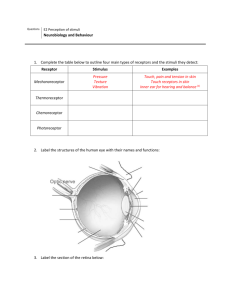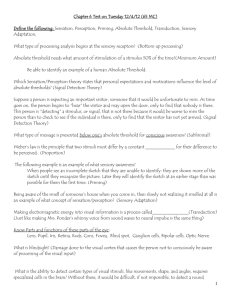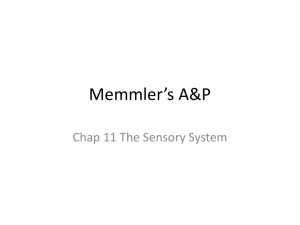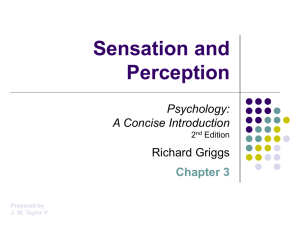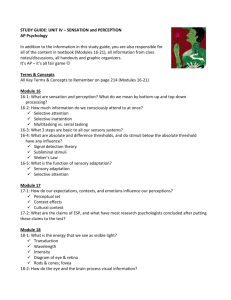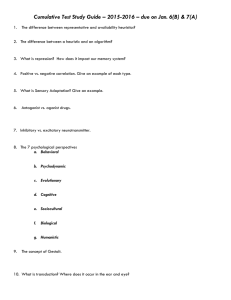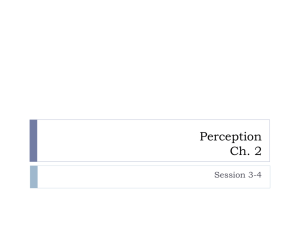Sensation and Perception
advertisement
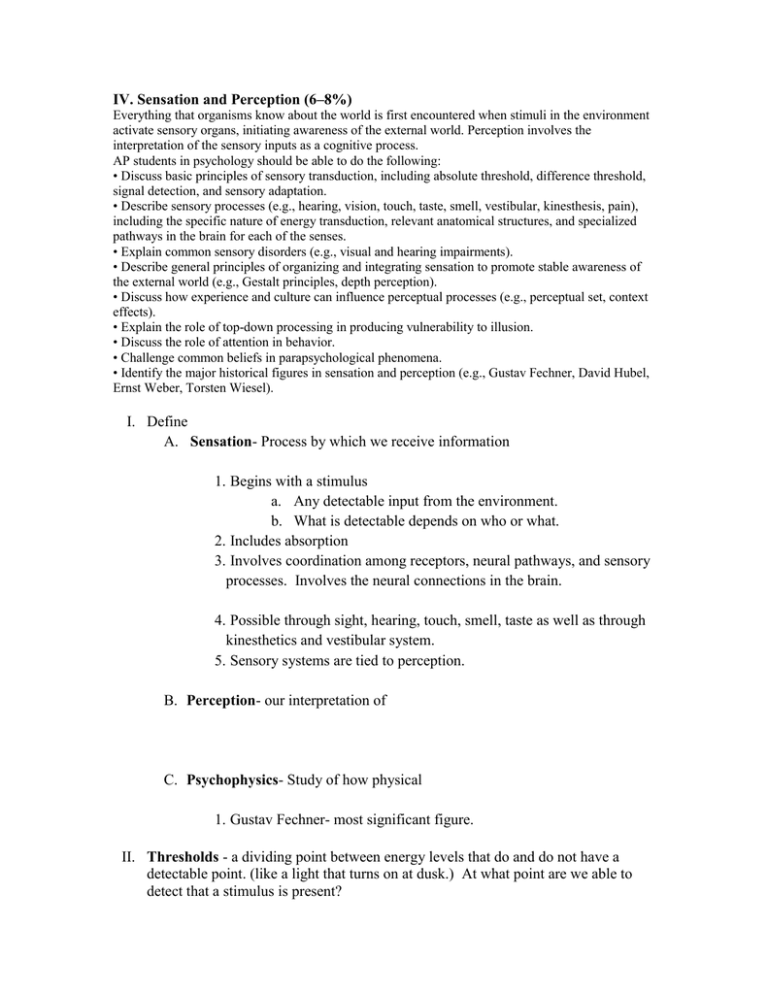
IV. Sensation and Perception (6–8%) Everything that organisms know about the world is first encountered when stimuli in the environment activate sensory organs, initiating awareness of the external world. Perception involves the interpretation of the sensory inputs as a cognitive process. AP students in psychology should be able to do the following: • Discuss basic principles of sensory transduction, including absolute threshold, difference threshold, signal detection, and sensory adaptation. • Describe sensory processes (e.g., hearing, vision, touch, taste, smell, vestibular, kinesthesis, pain), including the specific nature of energy transduction, relevant anatomical structures, and specialized pathways in the brain for each of the senses. • Explain common sensory disorders (e.g., visual and hearing impairments). • Describe general principles of organizing and integrating sensation to promote stable awareness of the external world (e.g., Gestalt principles, depth perception). • Discuss how experience and culture can influence perceptual processes (e.g., perceptual set, context effects). • Explain the role of top-down processing in producing vulnerability to illusion. • Discuss the role of attention in behavior. • Challenge common beliefs in parapsychological phenomena. • Identify the major historical figures in sensation and perception (e.g., Gustav Fechner, David Hubel, Ernst Weber, Torsten Wiesel). I. Define A. Sensation- Process by which we receive information 1. Begins with a stimulus a. Any detectable input from the environment. b. What is detectable depends on who or what. 2. Includes absorption 3. Involves coordination among receptors, neural pathways, and sensory processes. Involves the neural connections in the brain. 4. Possible through sight, hearing, touch, smell, taste as well as through kinesthetics and vestibular system. 5. Sensory systems are tied to perception. B. Perception- our interpretation of C. Psychophysics- Study of how physical 1. Gustav Fechner- most significant figure. II. Thresholds - a dividing point between energy levels that do and do not have a detectable point. (like a light that turns on at dusk.) At what point are we able to detect that a stimulus is present? A. Absolute threshold- The point at which a stimulus 1. Given a particular stimulus, the minimum intensity of stimulation needed to produce a sensation at least 50% of the time. 2. Subliminal perception- information below the threshold- Studies have shown it does influence people- when flashed a positive slide and then shown a picture of a person describe them more positively and vice versa. B. Difference threshold or 1. Minimum change in the intensity of 2. Weber’s law- states that there is a constant proportion (not amount) between the threshold and the stimulus for each sense quality. For example we notice an inch that is added to a goldfish more than an inch that is added to an elephant. ∆S = K S **∆S = change in the intensity of the stimulation S= the stimulation already there K= the constant value for each sensory quality a. This means that the amount of change in the stimuli that is necessary in the stimulation depends on what level is present of stimulation. b. Some senses are c. JND stands for the Just Noticeable Difference- it is the difference 3. Signal Detection theory- Proposes that the detection of stimuli involves a. Term was prominent in the 1960s applied to detection of radar and soviet missiles. b. Present Absent Responder says a stimulus is present Responder says a stimulus is not present c. Liberal responders prefer to say yes d. This begins to beg the question- what are the factors that influence our sensory judgment. III. Receptors A. Environmental Information (stimuli) exists in many forms: 1. Air vibrations, gases, chemicals, tactile pressure 2. Body receives the info through specialized cells. a. Receptors work as transducersb. E.g.- taste buds on the tongue convert chemical signals to a pattern of electrochemical activity sent to the brain. B. Receptor sensitivity is subject to change. 1. Sensory adaptation- Gradual decline in sensitivity to a. Decline in receptor activity b. E.g.- 2. Habituation- is all in your interpretation a. Decrease in sensory sensitivity at b. Different from sensory adaptation in that responsiveness can reappear if stimulation level is increased or decreased. c. Example Lesson 2 Vision Sense Organ Universal Energy Source Human Threshold Extra info Label the Eye Diagram #2 Human Anatomy Read the definitions, then label the eye anatomy diagram below. Cornea - the clear, dome-shaped tissue covering the front of the eye. Eyebrow - a patch of dense hair located above the eye. Eyelash - one of the many hairs on the edge of the eyelids. Eyelid - the flap of skin that can cover and protect the eye. Iris - the colored part of the eye - it controls the amount of light that enters the eye by changing the size of the pupil. Lens - a crystalline structure located just behind the iris - it focuses light onto the retina. Optic nerve - the nerve that transmits electrical impulses from the retina to the brain. Pupil - the opening in the center of the iris- it changes size as the amount of light changes (the more light, the smaller the hole). Retina - sensory tissue that lines the back of the eye. It contains millions of photoreceptors (rods and cones) that convert light rays into electrical impulses that are relayed to the brain via the optic nerve. Tear - clear, salty liquid that is produced by glands in the eyes. Vitreous - a thick, transparent liquid that fills the center of the eye - it is mostly water and gives the eye its form and shape (also called the vitreous humor). A. Characteristics of light. B. Color theories 1. Young- Hemholtz Trichromatic Theory 2. Opponent Processing Theory C. Color blindness- Color deficiency1. Dichromacy- the person can distinguish only between 2 colors pairs 2. Monochromacy- completely color blind- very rare condition. Lesson 3 Audition Sense Organ Universal Source of Energy Human Threshold Label the Ear Anatomy Diagram Additional Info Human Anatomy Sound is collected by the pinna (the visible part of the ear) and directed through the outer ear canal. The sound makes the eardrum vibrate, which in turn causes a series of three tiny bones (the hammer, the anvil, and the stirrup) in the middle ear to vibrate. The vibration is transferred to the snail-shaped cochlea in the inner ear; the cochlea is lined with sensitive hairs which trigger the generation of nerve signals that are sent to the brain. Read the definitions below, then label the ear anatomy diagram. anvil - (also called the incus) a tiny bone that passes vibrations from the hammer to the stirrup. cochlea - a spiral-shaped, fluid-filled inner ear structure; it is lined with cilia (tiny hairs) that move when vibrated and cause a nerve impulse to form. eardrum - (also called the tympanic membrane) a thin membrane that vibrates when sound waves reach it. Eustachian tube - a tube that connects the middle ear to the back of the nose; it equalizes the pressure between the middle ear and the air outside. When you "pop" your ears as you change altitude (going up a mountain or in an airplane), you are equalizing the air pressure in your middle ear. hammer - (also called the malleus) a tiny bone that passes vibrations from the eardrum to the anvil. nerves - these carry electrochemical signals from the inner ear (the cochlea) to the brain. outer ear canal - the tube through which sound travels to the eardrum. pinna - (also called the auricle) the visible part of the outer ear. It collects sound and directs it into the outer ear canal semicircular canals - three loops of fluid-filled tubes that are attached to the cochlea in the inner ear. They help us maintain our sense of balance. stirrup - (also called the stapes) a tiny, U-shaped bone that passes vibrations from the stirrup to the cochlea. This is the smallest bone in the human body (it is 0.25 to 0.33 cm long). Complexity Frequency Amplitude C. Characteristics of sound D. Audition theories Place Theory Frequency Theory Volley principle •Difference frequencies cause vibrations at different locations along the basilar membrane •Increased frequency causes maximum vibration at t stirrup end, and decreased frequency at the other end •Assumes hair cells respond independently and different sets of hair cells are vibrated by different sound frequencies •Explains lower pitch •Basilar membrane vibrates at the same frequency as the sound wave. Sound wave of 100 hrtz means the hair cells vibrate at 100 times per second •Neurons can’t fire at more than 1000 times per second •Holds that groups of auditory nerve fibers fire neural impulses in rapid succession, creating volleys of impulses •This means that while some are firing others are “reloading” E. Hearing Loss 1. Conduction hearing loss (ear drum damage, bones become brittle and fuse together)2. Sensorineural hearing loss (this is what rock musicians experience)- F. Sound Localization- how we identify where a sound is coming from. One ear receives information Lesson 4 Gustation Sense Organ Energy Source Human Threshold Extra info A. 5 basic taste qualities- receptors are sensitive to these 1. 2. Linda Bartashuk- Yale Medical- a taste research. Discovered there is no taste map (it was previously believed that different tastes qualities lay on different parts of the tongue)- the original German research was mistranslated. There is an evolutionary value to our taste. For example, bitterness helps us to know that there might be a poison. 3. Supertasters versus nontasters 4. Some basic taste preferences appear to be innate and automatically regulated by physiological mechanisms- newborns react positively to sweet and salty- and negatively to strong concentrations of bitter or sour tastes. B. Other influences on taste- smell, texture, temperature. What happens when you have a cold? You probably have more difficulty tasting because you can’t smell the food. Olfaction Sense Organ Universal Source of Energy Absolute Threshold Additional Info: A. Olfactory EpitheliumOlfactory Cilia1. Nasal cavity2. Olfactory bulb3. Gases- Olfactory cells in this membrane are stimulated 4. For stimulus to be smelled, it must be dissolved. B. Pheromones- sex attracting odor- Somosthesis Sense Organ Universal Energy Source Absolute Threshold Additional Info A. Kinesthesis B. Vestibular senses-also called equilibratory senses Lesson 5 I. Perceptual processes A. Attention- process in which consciousness is focused on particular stimuli 1. Selective attention- ability to focus on one stimulus while 2. Divided Attention- ability to respond to more than a. If you are using two different senses, it is easier to divide your attention b. It is harder to divide our attention the older we get B. Perceptual organization- process which group smaller units of the perceptual world into larger units. 1. Figure-ground- tendency to organize the visual field into objects that stand apart from the 2. Gestalt- we tend to organize our perceptions a. Principles of Gestalt organization i. Similarity- stimuli that are similar in size, shape, color or form tend to be grouped together ii. Proximity- Stimuli that are near each other are grouped together iii. Continuity- Perceptions tend toward simplicity or continuity- lines tend to be seen as following the smoothest path- line interrupted by an overlapping object are seen as belonging together if the result in straight or gently curving lines when connected iv. Closure- figures that have gaps in them are seen as completed and perceived as recognizable objects. v. Simplicity- every stimulus pattern is perceived in such a way that the resulting structure is as simple as possible vi. Phi Phenomenon- Perceived motion when the object is, in fact, stationery. (when two lights are placed in a dark room and flashed alternately, one light moving back and forth is perceived) Theatre marquees- when words appear to move from one side to the other as different combinations of stationary lights are flashed on and off. II. Perceptual abilities- our brains interpret stimuli in such a way as to impose stability on the environment. We override the literal sensory messages with prior knowledge. A. Perceptual constancy 1. Size constancy- we see a car as being the same size in spite of the fact that the image on the retina becomes smaller as the car moves away from us. 2. Shape constancy- gives us the message that the car’s tires are still round although the retina has the image of an ellipse as the car turns a corner. 3. Brightness or lightness constancy- objects appear to stay the same brightness despite changes in the amount of light falling on them. If a cloud cover changes the light in the vicinity, we do not see the car as being less white than it was B. Binocular Cues- our eyes and brain work 1. Binocular disparity- (retinal disparity) The retina of each eye gets 2. Convergence- involves the interpretation of C. Monocular cues- cues provided by one eye 1. Linear perspective- parallel lines appear to converge on the horizon (RR tracks) 2. Relative Size- close objects appear larger 3. Overlap or interposition- objects that are overlapped or partially concealed by other objects will appear farther away 4. Gradient of texture- objects that are closer have greater detail or texture than those farther away 5. Arial perspective- closer objects are bright and sharp- distant objects are pastel and hazy 6. Relative motion or motion parallax- when moving our head from side to side, nearby objects appear to move more than distant objects, far objects appear to move slower than nearby objects 7. Height on plane- objects that are closer appear to be lower in the field than objects that are farther away. 8. Accommodation- lens of eye must bend or adjust to bring to focus objects that are relatively close. D. Pattern Perception- enables us to recognize faces, objects, words and other organized patterns in the environment. 1. Bottom up processing2. Top-down processingE. Other information 1. Perceptual set- mental predisposition- such as motivation, values, expectations, cognitive style, experience and culture and personality can all effect what we see. 2. Perceptual illusion- occur because the stimulus contains misleading cues that distort the perceived size or orientation of common objects giving rise to inaccurate or impossible perceptions
